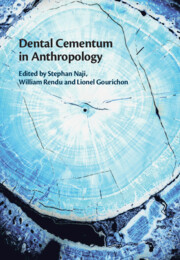Book contents
- Dental Cementum in Anthropology
- Dental Cementum in Anthropology
- Copyright page
- Dedication
- Contents
- Contributors
- Foreword
- Introduction: Cementochronology in Chronobiology
- Part I The Biology of Cementum
- Part II Protocols
- Part III Applications
- 17 Using Cementochronology to Discuss the Organization of Past Neanderthal Societies
- 18 Investigating Seasonal Competition between Hominins and Cave Hyaenas in the Belgian Ardennes during the Late Pleistocene: Insights from Cementum Analyses
- 19 Cementochronology to the Rescue: Osteobiography of a Middle Woodland Woman with a Combined Skeletal Dysplasia
- 20 Estimating a Mortality Profile of Fisher-Gatherers in Brazil Using Cementochronology
- 21 Cementochronology: A Solution to Reconstructing Past Populations’ Mortality Profiles Using Individual Age-at-Death Estimates
- 22 Assessing Age-Related Mortality at Petra, Jordan, Using Cementochronology and Hazard Modeling
- 23 Shaping Age-at-Death Distributions by Applying Tooth Cementum Analysis to the Early Medieval Graveyard of Lauchheim (Germany)
- 24 Back to the Root: The Coming of Age of Cementochronology
- Index
- Plate Section (PDF Only)
- References
24 - Back to the Root: The Coming of Age of Cementochronology
from Part III - Applications
Published online by Cambridge University Press: 20 January 2022
- Dental Cementum in Anthropology
- Dental Cementum in Anthropology
- Copyright page
- Dedication
- Contents
- Contributors
- Foreword
- Introduction: Cementochronology in Chronobiology
- Part I The Biology of Cementum
- Part II Protocols
- Part III Applications
- 17 Using Cementochronology to Discuss the Organization of Past Neanderthal Societies
- 18 Investigating Seasonal Competition between Hominins and Cave Hyaenas in the Belgian Ardennes during the Late Pleistocene: Insights from Cementum Analyses
- 19 Cementochronology to the Rescue: Osteobiography of a Middle Woodland Woman with a Combined Skeletal Dysplasia
- 20 Estimating a Mortality Profile of Fisher-Gatherers in Brazil Using Cementochronology
- 21 Cementochronology: A Solution to Reconstructing Past Populations’ Mortality Profiles Using Individual Age-at-Death Estimates
- 22 Assessing Age-Related Mortality at Petra, Jordan, Using Cementochronology and Hazard Modeling
- 23 Shaping Age-at-Death Distributions by Applying Tooth Cementum Analysis to the Early Medieval Graveyard of Lauchheim (Germany)
- 24 Back to the Root: The Coming of Age of Cementochronology
- Index
- Plate Section (PDF Only)
- References
Summary
Tremendous progress has been made since cementum analysis first applications in the 1950s. Today, with a better understanding of cementum biology, robust, replicable protocols support promising innovative research. Now, cementum should be considered within a broader evolutionary framework and cementogenesis tested from chronobiology theoretical assumptions to identify genetic or environmental variables affecting its circannual growth. With the rise of image analysis automation and optimization of species-specific standardized protocols, cementochronology is mature for site-level experiments. Also, the groundbreaking evolution of noninvasive, 3D cementochronology opens opportunities to study the fossil record, from stem-mammals to our Homo lineage. The breadth of applications across disciplines is a testament to cementochronology as a unique tool to investigate age and season at death, mobility patterns, life-history events, or mammalian evolutionwhich should be deployed broadly in anthropology. The goal of this volume is to promote collaborative efforts and stimulate interdisciplinary opportunities to renew diverse anthropology themes using cementum in anthropology.
Keywords
- Type
- Chapter
- Information
- Dental Cementum in Anthropology , pp. 379 - 393Publisher: Cambridge University PressPrint publication year: 2022



